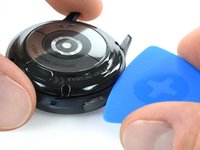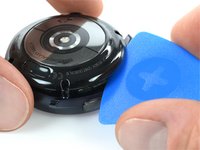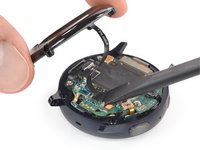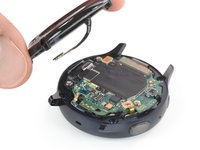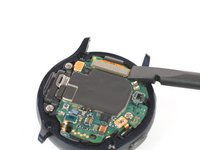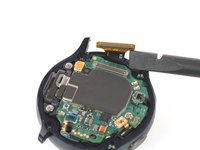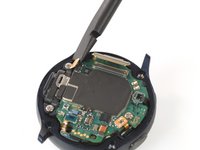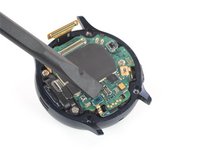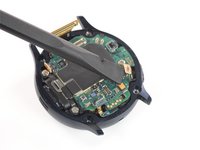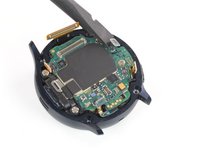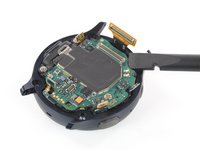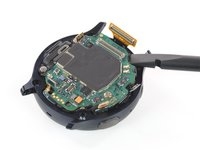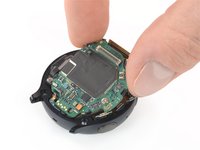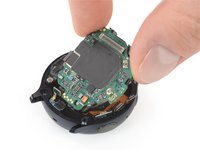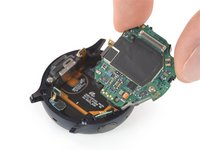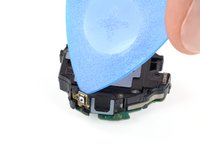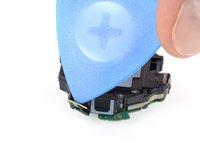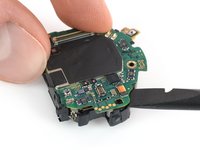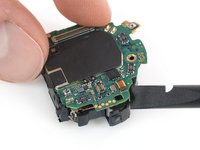crwdns2915892:0crwdne2915892:0
Use this guide to replace a defective motherboard in your Samsung Galaxy Watch Active2.
crwdns2942213:0crwdne2942213:0
-
-
Turn off the Galaxy Watch Active2 by pushing and holding the bottom button for approximately 3 seconds. You should feel a short vibration.
-
When the "Power off" symbol appears, tap the center of the screen to make it shut down. You should feel a longer vibration for confirmation.
-
-
-
Use a Tri-point Y00 screwdriver to remove the four 4 mm-long screws on the back of the watch.
Y1.5 works just as good
Bekomme ich nicht auf … Schrauben zu fest
The screws are attached to the cover. So you just need to loose them, not remove them.
Any tips for a too tight screw ?
-
-
-
Use an opening pick and place it between the plastic back cover and the metal housing near the buttons.
-
Push the opening pick into the gap to separate the back cover from the housing.
There is a glue-ish gasket keeping it closed. I used an exacto knife to start it opening.
This was super helpful thank you! Perfect timing
Waarmee kan ik de achterste oplaadplaat weer vast lijmen op de achterste behuizing
-
-
-
Carefully lift the back cover to access the sensor array connector.
-
Use a spudger to disconnect the sensor array from the motherboard.
-
-
-
Remove the back cover.
Where would you recommend buying a new back panel/charger?
Una pregunta. y para poner el reemplazo sería necesario algún tipo de sellador o silicón?porque pues usualmente este tipo de tapas vienen sellados de fabrica para evitar cualquier posibilidad de que le pudiera entrar agua
-
-
-
-
Use a spudger to disconnect the display assembly and the speaker.
-
-
-
Use a spudger to disconnect the barometric sensor, the buttons, and the microphone.
-
-
-
Place a spudger underneath the motherboard at the top right next to the display connector.
-
Slightly twist and lever the spudger to loosen the core assembly.
I would not suggest to do so. There are components underneath the motherboard as well. There are none in this specific corner, but the core assembly does not come out that easily and people might try other corners and positions. Rather unscrew the motherboard and remove the battery from the core assembly directly.
Yes! I was unable to remove the motherboard as pictured unless the screw was removed (Step 12). I suggest a re-ordering of steps in this guide.
You have to sort of wiggle it up from all sides and gradually lift out the corner/sides adjacent to the spludger as shown. I took a few minutes doing it carefully, it's fairly snug. Avoid pulling the motherboard out from only one side if you must at your risk.
-
-
-
Grab the core assembly and carefully slide it out from under the cables.
-
Remove the core assembly.
I had to remove that screw on the core assembly using a Phillips 000. When I initially tried lifting, the core assembly started to bend. Mine also has a connector under the core assembly near the thumb in the picture. The connector goes from the underside of the core assembly to the screen/body. It prevents me from removing the core assembly as I'm not sure how it should be removed examining it
This step is really difficult, and I'm still not sure it was necessary. The core assembly is really packed in there, and it took me several attempts, lifting from various corners. Don't pull by the circuit board. It will bend if you're not careful. You've got to get under the core assembly. I had the most luck starting next to the display connector at the top, then moving to the sensor on the other end of the board (barometric sensor), then moving to the speakers on the left, and finally lifting from multiple points once it was out far enough. In really hoping I didn't damage anything.
I think the comments here should be added to the step before.
I would be very careful following Louis Finney's advice above. They are describing detaching the motherboard from the core assembly which also includes the battery and internal frame. Removing the motherboard from the rest of the core assembly exposes a very delicate looking ribbon cable that I nearly tore by trying to remove the screw holding the motherboard in place.
As Karl Arp notes, trying to pry the core assembly up by the motherboard feels like it puts a lot of strain on the circuit board, so it might be necessary to go at it from multiple angles.
Removing the whole core assembly was very difficult, and required a lot more force than I was expecting, and I had the luxury of being able to approach it from both sides, as the screen had already detached from the device (hence the need to repair), and still found it very challenging.I would advise, at a minimum applying mild heat to the metal outer frame to hopefully cause it to expand and give some additional clearance.
Goede middag hier bij stap 10 is het fout gegaan bij mij,
De knop waar je hem mee aan uit zet is afgebroken snik snik.
Nu lig ik eruit.
Maar de uitleg die je geeft is prefect kan niet beter.
Vraag is er nog hoop voor mij..
B.v.D.
-
-
-
Flip the core assembly over so the motherboard faces down.
-
-
-
Use the tip of an opening pick to peel the top button off the plastic frame.
-
-
-
Use a Phillips screwdriver to remove the 4.4 mm-long screw holding the motherboard in place.
-
-
-
Place the flat end of a spudger between the motherboard and the plastic frame near the copper coil at the bottom right.
-
Twist the spudger to free the motherboard from the plastic tabs.
-
-
-
Slide the motherboard out from under the remaining plastic tabs to remove it.
-
Compare your new replacement part to the original part—you may need to transfer remaining components or remove adhesive backings from the new part before installing.
To reassemble your device, follow these instructions in reverse order.
Take your e-waste to an R2 or e-Stewards certified recycler.
Repair didn’t go as planned? Try some basic troubleshooting, or ask our Answers community for help.
Compare your new replacement part to the original part—you may need to transfer remaining components or remove adhesive backings from the new part before installing.
To reassemble your device, follow these instructions in reverse order.
Take your e-waste to an R2 or e-Stewards certified recycler.
Repair didn’t go as planned? Try some basic troubleshooting, or ask our Answers community for help.
crwdns2935221:0crwdne2935221:0
crwdns2935229:04crwdne2935229:0
crwdns2947412:013crwdne2947412:0
Hi, I am having issues with bluetooth, is it a replacement or do I need to swap the MB? Thank you
When you have ruled out any software issues (tried restart, factory reset, software update, etc) then this is most likely a MB replacement since all the modules are integrated on that tiny thing.
does the watch active have the same motherboard as the watch active 2
Nope, the Watch Active has a different motherboard.
My watch stopped vibrating all together, which part do I need to replace?
This would be the vibration motor which is located under the battery (small cylindrical component on the bottom right with two golden contacts) seen in the last picture.
My active 2 watch has water damage is it cheaper to replace the part or parts or get a new one at this point?
The screen has 0 response.
You can always try and open it up to assess the damage and see which parts need replacing.
My watch stopped working after swimming in a pool, What part/s could it be that needs replacement?
Hard to say. But you can always try and open your watch to assess the damage and see which parts need replacing.
My watch is flickering .. What can I do ? what part need to be replaced?
If still under warranty, you might want to try and contact the seller.
If the watch is out of warranty it could be a loose display connector (try that first), a defective display, a weak solder joint or maybe water damage.
the power button on my active 2 is non responsive, I've tested the contacts across the button itself as well from the button to the main board and all have continuity. the responsiveness from the button has been getting worse over time. now it just no longer works is this a main board issue?








